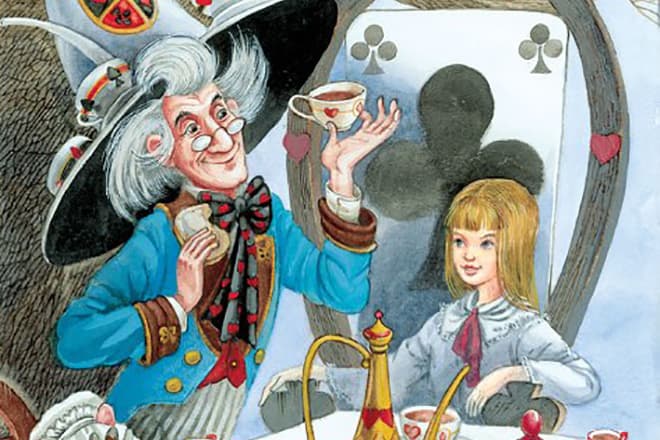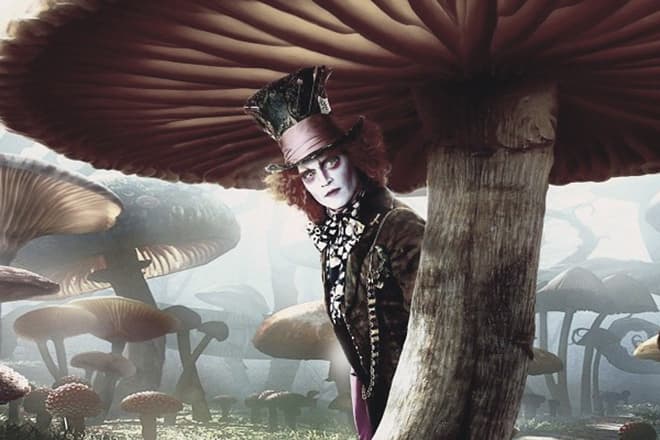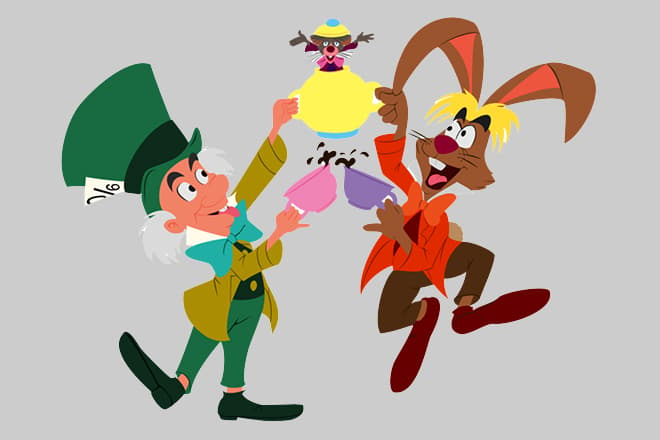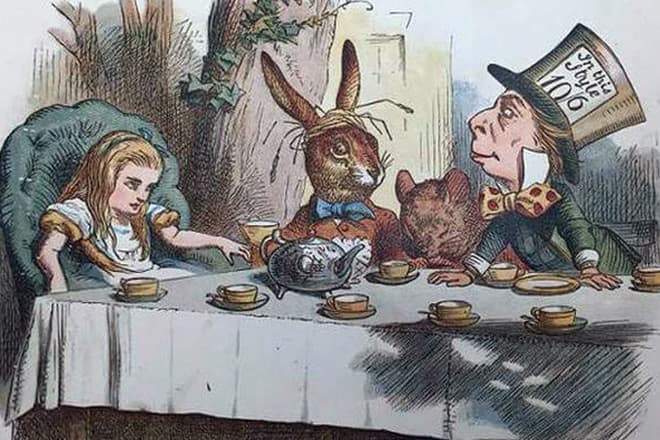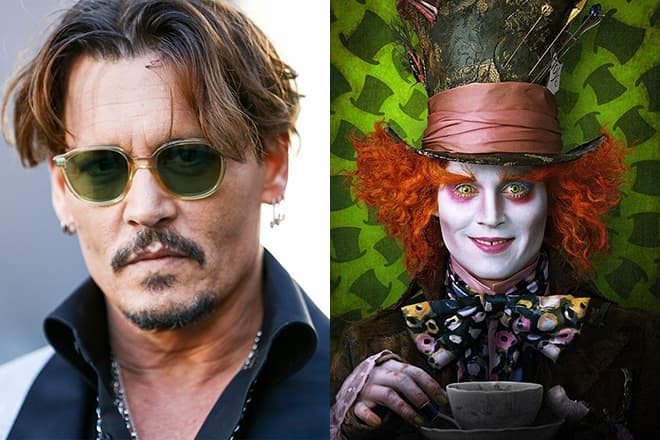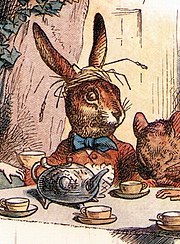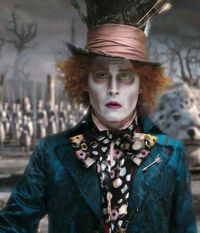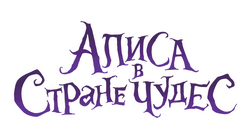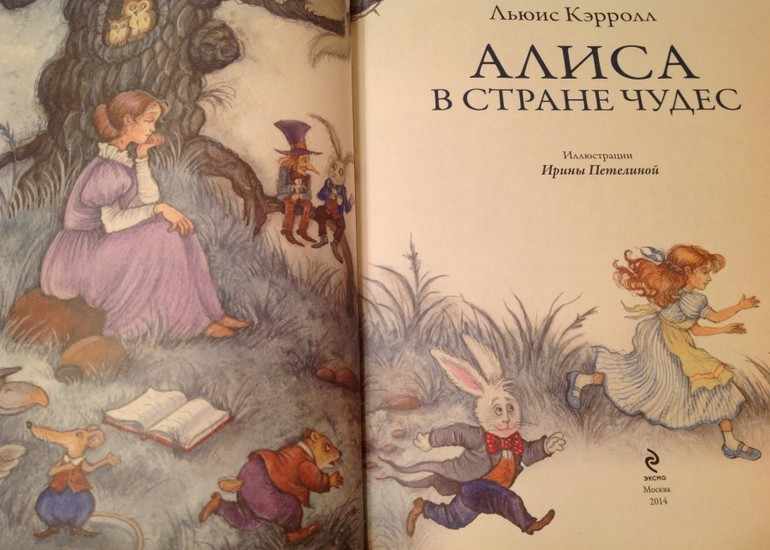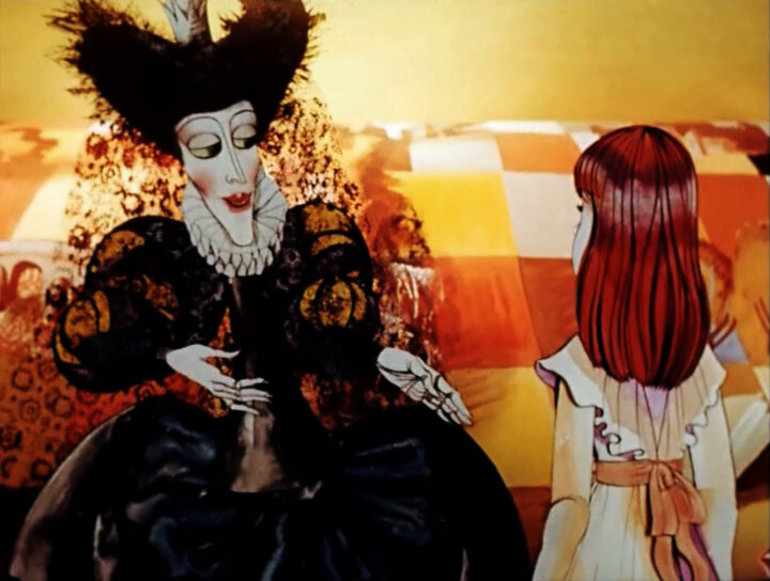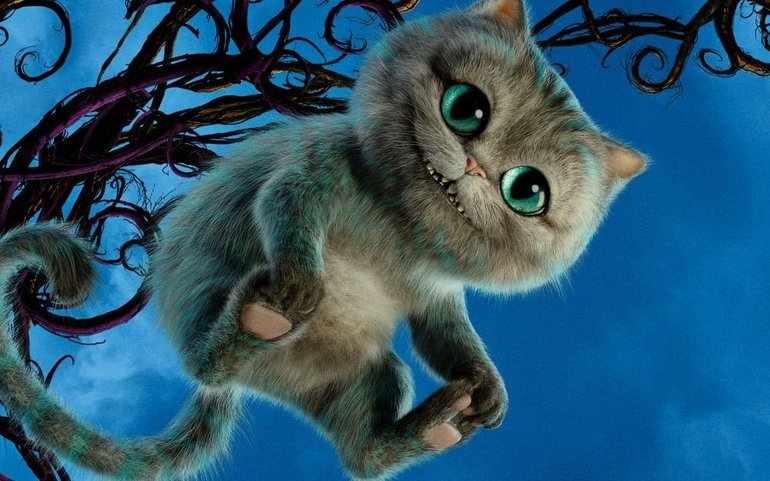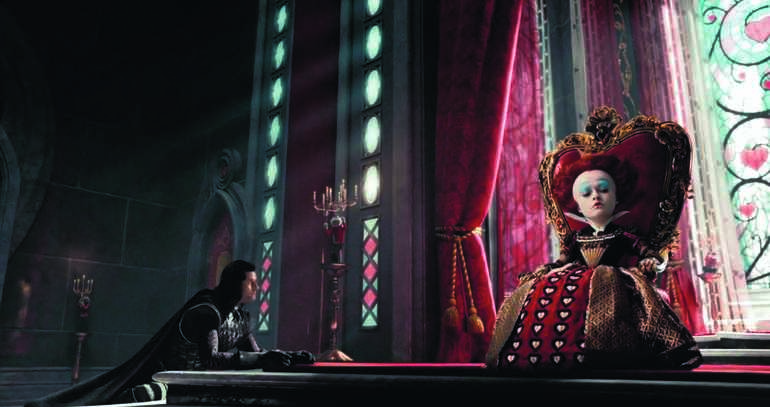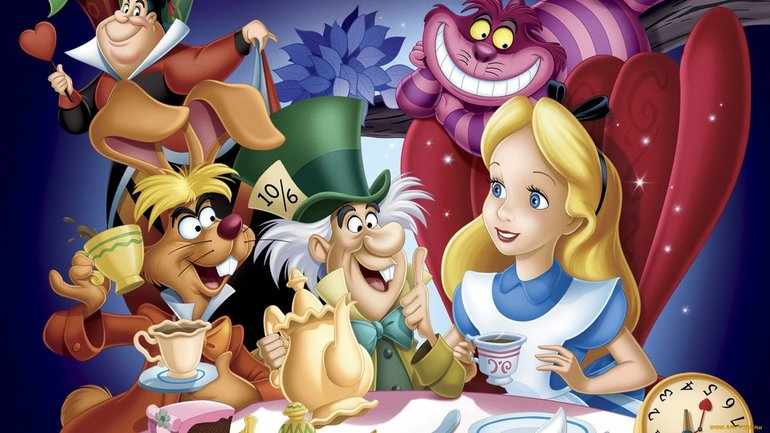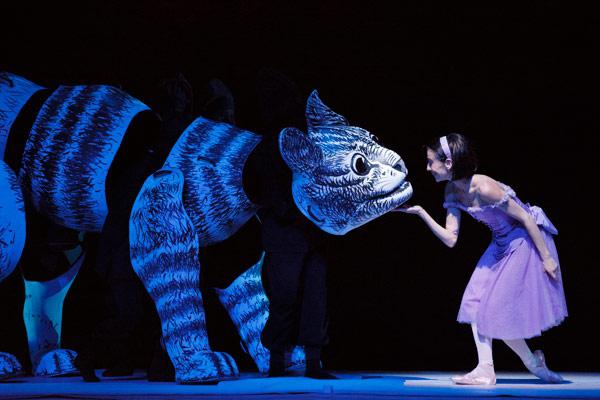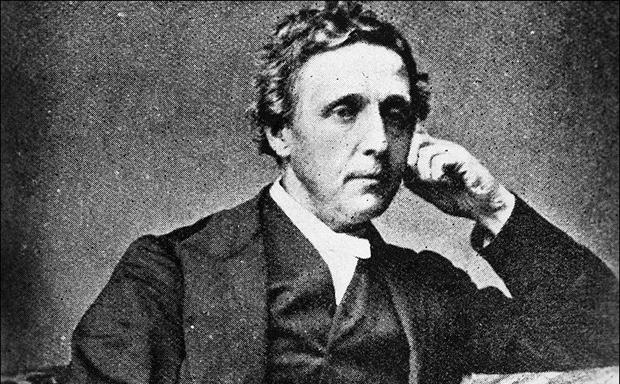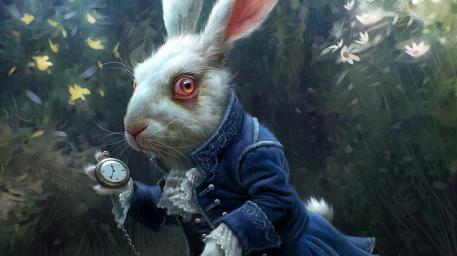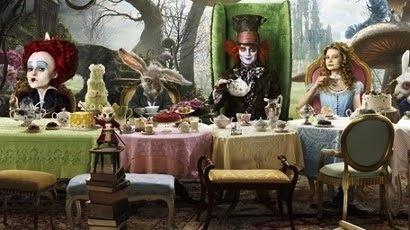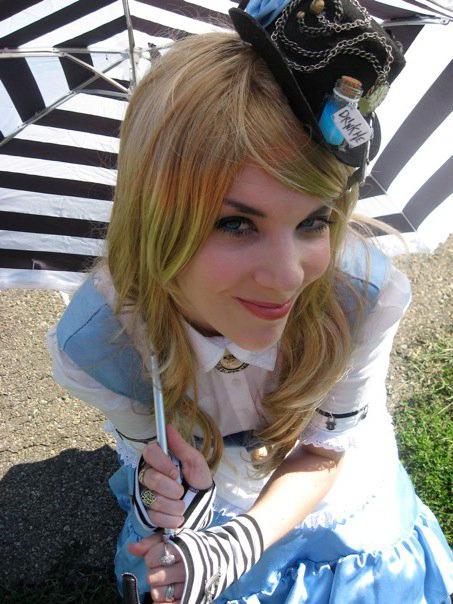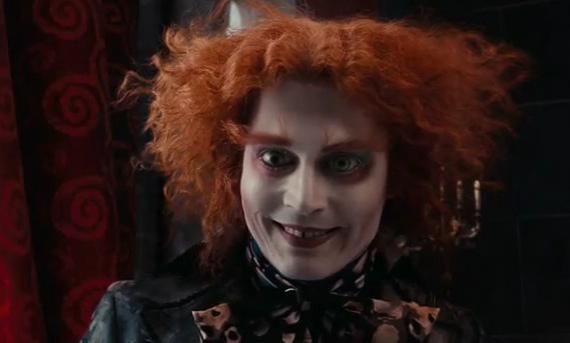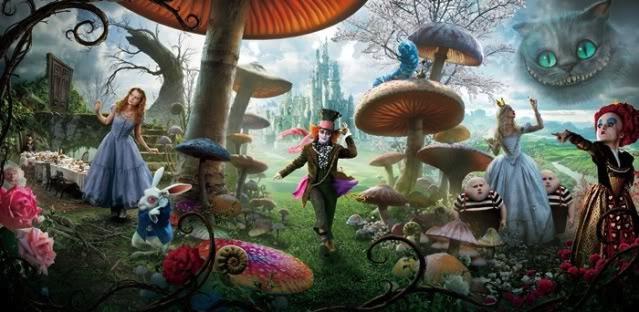История персонажа
Английский математик и писатель Льюис Кэрролл придумал персонажа по имени Безумный Шляпник, работая над сказкой «Приключения Алисы в Стране чудес». В некоторых вариантах перевода герой получил имя Болванщик, но чаще его называют привычным аудитории прозвищем.
Чтобы понять, что персонаж не от мира сего, необязательно вчитываться в пояснения Чеширского кота и разбираться в философствованиях героев на темы безумия. Его поведение странно и оправдывает имя. В полном загадок произведении Кэрролла герой находит себе уютное место в повествовании и становится самостоятельным персонажем в веренице невероятных героев.
Льюис Кэрролл – обладатель незаурядной фантазии, позволившей совместить любовь к математике и талант писателя. В литературе автор реализовал себя в фантастическом жанре. Помимо «Алисы в Стране чудес» он написал книги «Алиса в Зазеркалье», «Логическая игра» и «Математические курьезы».
Сказка об Алисе, попавшей в Страну чудес, – не просто фантастическая история, а продуманная цепочка ребусов и головоломок. Математик, любивший метафоры и загадки, наполнил символичными изображениями свои произведения.
История создания
Безумный Шляпник стал персонажем, чей образ эксплуатируется в современных сюжетах и легендах. Впервые зритель видит героя в сцене чаепития в книге «Алиса в Стране чудес». В мире Зазеркалья Кэрролл выводит нового персонажа – Болванса Чика, похожего на использованного ранее героя. Он также предстает перед публикой в седьмой главе книги.
Прототип Шляпника, по легенде, – продавец мебели Теофил Картер, непредсказуемый и эксцентричный герой, который носил прозвище Безумный Шляпник. Он, во-первых, всегда носил шляпу, а во-вторых – придумывал сумасшедшие штуки вроде кровати-будильника, сбрасывающей спящего на пол.
Роджер Крэбб тоже мог стать прообразом героя. Это солдат, поступивший на службу в 1642 году и получивший контузию в атаке на шотландцев. Удар повлиял на разум, и после увольнения ставший шляпником служивый не раз удивлял окружающих своим поведением.
Загадка Безумного Шляпника кроется еще и в том, что его характер является визуальным воплощением редкого заболевания. Болезнь под названием меркуриализм описывает отравление ртутными парами. Поражение веществом фиксировалось в 19 веке у работников, производящих шляпы. Нитрат ртути применялся для размягчения шерстяной материи при изготовлении фетра.
В помещениях не хватало свежего воздуха, нервная система работников подвергалась поражению, и симптомы отравления становились очевидными. Люди испытывали галлюцинации, чрезмерную эмоциональность, проблемы со зрением и слухом. Окружающие воспринимали их как умалишенных или безумцев, что дало повод для появления поговорки «as mad as a hatter» – «безумен, как шляпник».
Безумный Шляпник в произведениях
Непосредственный и наивный герой привлекает внимание читателя с момента первого появления на страницах произведения. Безумный Шляпник, характер которого отличается благородством, смелостью, харизмой и некоторой стеснительностью, талантлив и незауряден.
Он творец и фантазер, улыбающийся жизненным невзгодам в лицо. В сказке Льюиса Кэрролла он пьет чай с Мартовским зайцем и рассказывает о том, как был обвинен Королевой червей в убийстве времени. Шляпнику грозит казнь. Время, обидевшись на героя, остановилось. Теперь вместе с приятелем Мартовским зайцем Шляпник живет в нескончаемом пятичасовом перерыве на чай.
Участники мероприятия меняются местами, делают друг другу замечания, философствуют, произносят бессмысленные фразы и абстрагируются от Алисы. Второе появление Безумного Шляпника происходит на суде с участием Валета червей. Герой волнуется, что королева узнает его, но избегает казни.
В продолжении сказки персонаж оказывается под прицелом местного законодательства, но в этот раз он виноват лишь в перспективе. Персонаж выступает королевским глашатаем.
Безумный Шляпник – яркий образ повествования. Его внешность примечательна. Это молодой человек, неопрятный, но галантный джентльмен. Мастер, знающий толк в шляпах и умеющий делать парики. Крохотную Алису он доставляет в королевский дворец в головном уборе.
Экранизации
Впервые «Алиса в Стране чудес» была экранизирована в 1903 году. Сесил Хэпуорт снял 12-минутное немое кино. В проекте он взял на себя несколько функций и выступил как режиссер, оператор, актер, сценарист и продюсер ленты.
Образ Безумного Шляпника неоднократно воплощали талантливые артисты, создавая неповторимый облик героя. В сериале 1999 года Мартин Шорт воплотил образ, описанный в книге, и полностью соответствовал характеристике героя.
В мини-сериале «Алиса» представил образ Шляпника Эндрю Ли Поттс. Молодой человек в твидовой шляпе и кожаном пиджаке занимался благотворительностью, продавая эмоции. В ленте Шляпник становился возлюбленным Алисы.
Главным воплотителем образа Безумного Шляпника в последние десятилетия стал Джонни Депп. Неповторимый макияж персонажа в ленте Тима Бертона не оставил зрителей равнодушными. Мастер перевоплощения, Джонни Депп носил яркий рыжий парик и зеленые линзы, а его лицо было выбелено. Красочный костюм персонажа состоял из массы инструментов, пригодных для изготовления шляп. Он создавал впечатление безумца, отравившегося психотропным составом вроде клея.
По сюжету «Алисы в Стране чудес» снят сериал под названием «Однажды в сказке». Роль Шляпника в нем играет Себастиан Стэн, появляющийся на экране в первых трех сериях. Повествование гласит, что он живет в сказке о Белоснежке с дочкой Грейс. Они зарабатывают на жизнь продажей лесных грибов королеве и путешествуют от сказки к реальности в шляпе.
Цитаты
Льюис Кэрролл вложил в уста шляпника философские и юмористические цитаты, ставшие афоризмами.
«Нынче все ездят по железной дороге, но шляпные перевозки куда надежней и приятней».
Так говорит Шляпник, любезно предоставляя свой головной убор Алисе в качестве транспортного средства. Жизнеутверждающие реплики героя поддерживают героев и служат мотиватором для детской и взрослой читательской аудитории.
«Возможно, если ты в это веришь!»
Мечтательный сказочник провозглашает истины, актуальные для общества любого времени:
«Чем меньше знаешь, тем легче тобою управлять».
«Безумцы всех умней»
Это говорит отец Алисы, и эта фраза как нельзя лучше характеризует благородного и порядочного Шляпника. Он всегда выручит, неловко заявляя что-то вроде:
«А нужна причина, чтобы помочь очень милой девушке в очень мокром платье?»
Образ Шляпника романтизирован. Чтобы сделать его еще необычнее, Кэрролл подарил персонажу способность разговаривать на собственном языке, коверкая слова:
«Знаешь, Алиса, тебе стало не хватать гораздости…».
Не стоит забывать, что доля сумасшествия в образе Шляпника является неотъемлемой частью сущности, поэтому из его уст вырывается понятная одному ему тарабарщина:
«Ты думал лишь о собственном спасении, труснявый гадлый сверхноблохнущий брюхослизлый злыдный обжорст подлыймурк пахлорыбный?»
| The (Mad) Hatter | |
|---|---|
| Alice character | |

The Hatter as depicted by John Tenniel, reciting his nonsensical poem, «Twinkle, Twinkle, Little Bat» |
|
| First appearance | Alice’s Adventures in Wonderland (1865) |
| Last appearance | Through the Looking-Glass (1871) |
| Created by | Lewis Carroll |
| In-universe information | |
| Alias | Hatter Mad Hatter |
| Species | Human |
| Gender | Male |
| Occupation | Messenger, hatter |
| Nationality | Wonderland, Looking-glass world |
| Other versions | Tarrant Hightopp |
The Hatter is a fictional character in Lewis Carroll’s 1865 book Alice’s Adventures in Wonderland and its 1871 sequel Through the Looking-Glass. He is very often referred to as the Mad Hatter, though this term was never used by Carroll. The phrase «mad as a hatter» pre-dates Carroll’s works. The Hatter and the March Hare are referred to as «both mad» by the Cheshire Cat, in Alice’s Adventures in Wonderland in the sixth chapter titled «Pig and Pepper».
Fictional character biography[edit]
Alice’s Adventures in Wonderland[edit]
The Hatter character, alongside all the other fictional beings, first appears in Lewis Carroll’s 1865 novel Alice’s Adventures in Wonderland. In «Chapter Seven – A Mad Tea-Party», while exploring Wonderland, Alice comes across the Hatter having tea with the March Hare and the Dormouse. The Hatter explains to Alice that they are always having tea because when he tried to sing for the foul-tempered Queen of Hearts, she sentenced him to death for «murdering the time», but he escapes decapitation. In retaliation, Time (referred to as «he» by the Hatter) halts himself in respect to the Hatter, keeping him stuck at 6:00 pm (or 18:00) forever.
When Alice arrives at the tea party, the Hatter is characterised by switching places on the table at any given time, making short, personal remarks, asking unanswerable riddles, and reciting nonsensical poetry, all of which eventually drives Alice away. The Hatter appears again in «Chapter Eleven – Who Stole the Tarts?», as a witness at the Knave of Hearts’ trial, where the Queen appears to recognise him as the singer she sentenced to death, and the King of Hearts also cautions him not to be nervous or he will have him «executed on the spot».
Through the Looking-Glass[edit]
The character also appears briefly in Carroll’s 1871 Through the Looking-Glass, the sequel to Alice’s Adventures in Wonderland. Under the name of «Hatta,» the Hatter was in trouble with the law once again. He was, however, not necessarily guilty, as the White Queen explained that subjects were often punished before they commit a crime, rather than after, and sometimes they did not even commit one at all. He was also mentioned as one of the White King’s messengers along with March Hare, who went under the name of «Haigha.» Sir John Tenniel’s illustration depicts Hatta as sipping from a teacup as he did in the original novel. Alice does not comment on whether Hatta is the Hatter of her earlier dream.
Characterization[edit]
Etymology[edit]
Mercury was used in the manufacturing of felt hats during the 19th century, causing a high rate of mercury poisoning among those working in the hat industry.[1] Mercury poisoning causes neurological damage, including slurred speech, memory loss, and tremors, which led to the phrase «mad as a hatter».[1] In the Victorian age, many workers in the textile industry, including hatters, sometimes developed illnesses affecting the nervous system, such as central nervous system (CNS) tuberculosis, which is portrayed in novels like Alton Locke by Charles Kingsley and North and South by Elizabeth Gaskell, which Lewis Carroll had read. Many such workers were sent to Pauper Lunatic Asylums, which were supervised by Lunacy Commissioners such as Samuel Gaskell and Robert Wilfred Skeffington Lutwidge, Carroll’s uncle. Carroll was familiar with the conditions at asylums and visited at least one, the Surrey County Asylum, himself, which treated patients with so-called non-restraint methods and occupied them, amongst others, in gardening, farming and hat-making.[2] Besides staging theatre plays, dances and other amusements, such asylums also held tea-parties.[3]
Appearance[edit]
Although, during the trial of the Knave of Hearts, the King of Hearts remarks upon the Hatter’s headgear, Carroll does not describe the exact style of hat he wears. The character’s signature top hat comes from John Tenniel’s illustrations for the first edition, in which the character wears a large top hat with a hatband reading «In this style 10/6». This is further elaborated on in The Nursery «Alice», a shortened version of Alice’s Adventures in Wonderland, adapted by the author himself for young children. Here it is stated that the character is wearing a hat on his head with a price tag containing the numbers 10 and 6, giving the price in pre-decimal British money as ten shillings and six pence (or half a guinea).[4]
Personality[edit]
Illustration of the March Hare, one of the Hatter’s tea party friends, by Sir John Tenniel.
The Hatter and his tea party friend, the March Hare, are initially referred to as «both mad» by the distinctive Cheshire Cat. The first mention of both characters occurs in the sixth chapter of Carroll’s Alice’s Adventures in Wonderland, titled «Pig and Pepper», in a conversation between the child protagonist Alice and the Cheshire Cat, when she asks «what sort of people live about here?» to which the cat replies «in that direction lives a Hatter, and in that direction, lives a March Hare. Visit either you like: they’re both mad!» Both then subsequently make their actual debuts in the seventh chapter of the same book, which is titled «A Mad Tea-Party».
Hat making was the main trade in Stockport where Carroll grew up, and it was not unusual then for hatters to appear disturbed or confused; many died early as a result of mercury poisoning. However, the Hatter does not exhibit the symptoms of mercury poisoning, which include excessive timidity, diffidence, increasing shyness, loss of self-confidence, anxiety, and a desire to remain unobserved and unobtrusive.[5]
Resemblance to Theophilus Carter[edit]
It has often been claimed that the Hatter’s character may have been inspired by Theophilus Carter, an eccentric furniture dealer.[6][7] Carter was supposedly at one time a servitor at Christ Church, one of the University of Oxford’s colleges.[8] This is not substantiated by university records.[8] He later owned a furniture shop, and became known as the «Mad Hatter» from his habit of standing in the door of his shop wearing a top hat.[6][7] Sir John Tenniel is reported to have come to Oxford especially to sketch him for his illustrations.[6] There is no evidence for this claim, however, in either Carroll’s letters or diaries.[9]
Riddle[edit]
In the chapter «A Mad Tea Party», the Hatter asks a much-noted riddle: «Why is a raven like a writing desk?» When Alice gives up trying to figure out why, the Hatter admits «I haven’t the slightest idea!». Carroll originally intended the riddle to be without an answer, but after many requests from readers, he and others—including puzzle expert Sam Loyd—suggested possible answers; in his preface to the 1896 edition of Alice’s Adventures in Wonderland, Carroll wrote:
Inquiries have been so often addressed to me, as to whether any answer to the Hatter’s riddle can be imagined, that I may as well put on record here what seems to me to be a fairly appropriate answer, «because it can produce a few notes, though they are very flat; and it is nevar put with the wrong end in front!» This, however, is merely an afterthought; the riddle as originally invented had no answer at all.[10][a]
Loyd proposed a number of alternative solutions to the riddle, including «because Poe wrote on both» (alluding to Poe’s 1845 narrative poem The Raven) and «because the notes for which they are noted are not noted for being musical notes». The April 2017 edition of Bandersnatch, the Newsletter of the Lewis Carroll Society [Issue 172, ISSN 0306-8404, Apr 2017], published the following solution, proposed by puzzle expert Rick Hosburn: «Why is a Raven like a Writing-desk?» «Because one is a crow with a bill, while the other is a bureau with a quill!» The RSPB, in its definition of Raven, states: «The raven […] is all black with a large bill, and long wings.» American author Stephen King provides an alternative answer to the Hatter’s riddle in his 1977 horror novel The Shining. Snowbound and isolated «ten thousand feet high» in the Rocky Mountains, five-year-old Danny hears whispers of the malign «voice of the [Overlook] hotel» inside his head, including this bit of mockery: «Why is a raven like a writing desk? The higher the fewer, of course! Have another cup of tea!»
In popular culture[edit]
The Hatter has been featured in nearly every adaptation of Alice in Wonderland to date; he is usually the male lead despite being a supporting character. The character has been portrayed in film by Norman Whitten, Edward Everett Horton, Sir Robert Helpmann, Martin Short, Peter Cook, Anthony Newley, Ed Wynn, Andrew-Lee Potts, and Johnny Depp. In music videos, the Hatter has been portrayed by Tom Petty, Dero Goi, and Steven Tyler. He has also been portrayed on stage by Nikki Snelson and Katherine Shindle, and on television by John Robert Hoffman, Pip Donaghy and Sebastian Stan. In ballet adaptations, Steven McRae also portrayed him as a mad ‘Tapper’.[11] In March 2019, Chelsy Meiss became the first female soloist to play the Mad Hatter for the National Ballet of Canada.[12]
Films[edit]
- In the 1951 Walt Disney animated feature Alice in Wonderland, the Hatter appears as a short, hyperactive man with grey hair, a large nose and a comical voice. He was voiced by Ed Wynn in 1951, and by Corey Burton in his later appearances (Bonkers, House of Mouse). Alice stumbles upon the Hatter and the March Hare having an «un-birthday» party for themselves. The Hatter asks her the infamous riddle «why is a raven like a writing desk?», but when she tries to answer the Hatter and the March Hare think she is «stark raving mad» and the Hatter completely forgot that he even asked her the riddle. Throughout the course of the film, the Hatter pulls numerous items out of his hat, such as cake and smaller hats. His personality is that of a child; angry one second, happy the next.
- The Hatter appears in Tim Burton’s 2010 version of Alice in Wonderland portrayed by Johnny Depp and given the name Tarrant Hightopp.[13] In the film, the Hatter takes Alice toward the White Queen’s castle and relates the terror of the Red Queen’s reign while commenting that Alice is not the same as she once was. The Hatter subsequently helps Alice avoid capture by the Red Queen’s guards by allowing himself to be seized instead. He is later saved from execution by the Cheshire Cat and calls for rebellion against the Red Queen. Near the end of the film, the Hatter unsuccessfully suggests to Alice that she could stay in Wonderland and consummate his feelings for her.Critical reception to Johnny Depp’s portrayal of the Hatter was generally positive. David Edelstein of New York Magazine remarked that while the elements of the character suggested by Depp don’t entirely come together, «Depp brings an infectious summer-stock zest to everything he does.»[14] Bill Goodykoontz of The Arizona Republic said that «Depp is exactly what you’d expect, which is a good thing. Gap-toothed and leering, at times he looks like Madonna after sticking a fork in a toaster. How he finds his characters is anybody’s guess, a sort of thrift-store warehouse of eccentricities, it seems like. But it works.»[15] Owen Gleiberman of Entertainment Weekly had a more mixed opinion and commented that Depp as the Hatter is «a fantastic image, but once Depp opens his mouth, what comes out is a noisome Scottish brogue that makes everything he says sound more or less the same. The character offers no captivatingly skewed bat-house psychology. There isn’t much to him, really—he’s just a smiling Johnny one-note with a secret hip-hop dance move—and so we start to react to him the way that Alice does to everything else: by wondering when he’s going to stop making nonsense.»[16] Kenneth Turan of Los Angeles Times stated that «there’s no denying Depp’s gifts and abilities, but this performance feels both indulgent and something we’ve all seen before.»[17]
- The Hatter is played by Clarke Peters in the 2020 movie Come Away. He is depicted as the father of Captain Hook, the grandfather of Alice and Peter Pan, and the great-grandfather of Wendy Darling, John Darling, and Michael Darling.
Television[edit]
- The Hatter was also a semi-regular on the Disney Afternoon series Bonkers and one of the guests in House of Mouse, where he even made a cameo appearance in one of the featured cartoon shorts.
- The TV series Futurama has a robot named Mad Hatterbot who is based on the Hatter. Seen only in the HAL Institute (an asylum for criminally insane robots) the Mad Hatterbot only says one line: «Change places!», which all in the room comply with when spoken. The price tag on his hat reads «5/3», exactly half of 10/6. A minor character, he has been in the episodes «Insane in the Mainframe» and «Follow the Reader» as well as the film Futurama: Bender’s Game.
- In Syfy’s Alice, the Hatter (Andrew-Lee Potts) is portrayed as a smuggler who starts off working as a double agent for the Queen of Hearts and the Wonderland Resistance in the story; over the course of the story, he begins to side more and more with the Resistance, and ends up falling in love with Alice as he helps her along the way.
- In Once Upon a Time, the Mad Hatter is presented as possessing the unique ability to cross dimensions through his hat, and has a daughter, Grace, who lost her mother Priscilla[18] as a result of a past deal with the Evil Queen. When the Queen offers him enough wealth to set his daughter up for life, he agrees to help her travel to Wonderland, but when it is revealed that the goal was for the Queen to retrieve her captured father, the Hatter is left trapped in Wonderland instead, as the portal will only allow two people to pass through it in either direction. Trapped in Wonderland, he was then driven mad as he attempted to find another way back to his world to reunite with his daughter. In the first season, trapped in the Land Without Magic, the Mad Hatter- now known as ‘Jefferson’ as he lives in a mansion just on the outskirts of Storeybrooke- is one of the few who remembers his original life due to his insanity. His daughter has also been brought into Storeybrooke, but he has avoided making contact with her due to her new memories meaning that she would not recognise him. Unable to harness magic in this world, he attempts to recruit Emma to make a hat for him, but she is unable to harness her power, although Jefferson’s knowledge of the curse gives Emma further proof that Henry is telling the truth. Regina later recruits Jefferson to help her create a curse to use on Emma, but Regina’s efforts backfire and give Emma clear proof that the curse is real. In the second season, with the curse broken, Jefferson is eventually convinced to reunite with his daughter.
- In the Netflix’s Ever After High episode «Spring Unsprung», the Mad Hatter makes an appearance as Madeline Hatter’s father. In the 47-minute special, he runs the Mad Hatter’s Tea Shoppe in the town of Bookend, not far from Maddie’s school Ever After High. He also runs a shop by the same name in Wonderland, but it was abandoned after the Evil Queen (Raven Queen’s mother) cast a curse upon the land.
Video games[edit]
- In the 2000 video game American McGee’s Alice, The Mad Hatter is portrayed as psychotic, literally gone «mad» and obsessed with time and clockworks, and considers himself to be a genius. He invents mechanical devices, often evidently using the bodies of living organisms for the base of his inventions, as he plans to do to all of Wonderland’s inhabitants. He appears in the 2011 sequel Alice: Madness Returns in the same appearance, although this time, he requests Alice’s help in retrieving his lost limbs from his former compatriots the March Hare and Dormouse. The Hatter’s fixation on time might be based on the unseen character Time, which might explain why he replaced his body with cogs and gears as he sees Time as some type of god.
- The Hatter makes a cameo appearance in a painting in the Tea Party Garden in the 2002 video game Kingdom Hearts.
- The Mad Hatter appeared in the Sunsoft’s 2006 mobile game Alice’s Warped Wonderland (歪みの国のアリス, Yugami no kuni no Arisu, Alice in Distortion World). The Mad Hatter is portrayed as a middle-school age boy in oversized clothes and a large hat that covers his whole head. Unlike most Wonderland residents, he acts rather bratty and rude to Ariko (the «Alice» of the game). In one of the bad endings, Mad Hatter is killed by a twisted Cheshire Cat.[19][20]
- In Get Even, one of the asylum patients wearing the Pandora headsets dresses as the Hatter and has a tea party in his cell, he gives Cole Black a riddle to get the door open, there is a choice option to leave him in his room or set him free to which he’ll join the other inmates to kill Black, who they all believe is the «Puppet Master».
Music[edit]
- The song «Mad Hatter» by an American garage rock band Shag was inspired by the character. It appeared on their self-titled album in 1969.
- Sir John Tenniel’s drawing of the Hatter, combined with a montage of other images from Alice in Wonderland, were used as a logo by Charisma Records from 1972 onwards.
- A Burton’s inspired Mad Hatter appears in «The Man who became a Rabbit» music video, an Indian version of Alice in Wonderland by Valérian MacRabbit and Lalkrishnan. Mad Hatter becomes Mac Hatter and gives one riddle to the main character : «Spread blood on the birthday cake».[21]
- The Mad Hatter’s name is used in Elton John’s 1972 song Mona Lisas and Mad Hatters.
- The Mad Hatter is referenced to in the eponymous 2015 song by Melanie Martinez, next to a few other characters from Carroll’s Alice in Wonderland.[2]
Live performance[edit]
- The Hatter is a greetable character at the Disneyland Resort, Walt Disney World Resort, Tokyo Disney Resort, Disneyland Paris Resort and Hong Kong Disneyland.
- Shrek The Musical, the Mad Hatter plays a small role as a fairytale creature (replacing the Gnome) and has two lines in songs including «They ridiculed my hat» and «I smell like sauerkraut».
- Frank Wildhorn composed the music to and co-wrote the music to Wonderland: A New Alice. In this adaption the Hatter is portrayed as a female, the villain of the story, and Alice’s alter-ego and is a mad woman who longs to be Queen. She was played by Nikki Snelson in the original Tampa, Florida production, and then by Kate Shindle in the Tampa/Houston Tour, and the production on Broadway.
Comic strips and books[edit]
- The Mad Hatter (also referred to as «Jervis Tetch») is a supervillain and enemy of the Batman in DC comic books, making his first appearance in the October 1948 (#49) release of Batman.[22] He is portrayed as a brilliant neurotechnician with considerable knowledge in how to dominate and control the human mind.[23] Jervis had a obsession over Lewis Carroll’s books that he believes himself to be the reincarnation of the Mad Hatter, including making his henchmen wear outfits based on the Wonderland characters and kidnapping women and force them to dress and named them Alice.
- A spin-off of the traditional Alice in Wonderland story, Frank Beddor’s The Looking Glass Wars features a character named Hatter Madigan, a member of an elite group of bodyguards known in Wonderland as the «Millinery» after the business of selling women’s hats. He acts as the bodyguard of the rightful Queen, and as guide/guardian to the protagonist, Alyss Heart.
- The Mad Hatter in Pandora Hearts manga series is a chain (creature from the Abyss) that was contracted by Xerxes Break. The hatter basically looks like a large top hat with flowery decorations (similar to Break’s top hat) and a tattered cape. When summoned, it can destroy all chains and objects from the Abyss within a large area.
- The Japanese manga Alice in the Country of Hearts has been translated into English. The Hatter role is played by Blood Dupre, a crime boss and leader of a street gang called The Hatters, which controls one of the four territories of Wonderland.
Toys[edit]
- The Hatter has a daughter named Madeline in Ever After High toy line.
See also[edit]
- March Hare
- Dormouse
Notes[edit]
- ^ Here, Caroll deliberately spelled the word «never» as «nevar», which is «raven» backward.
References[edit]
- ^ a b Myers 2003, p. 276.
- ^ a b Kohlt, Franziska (26 April 2016). «‘The Stupidest Tea-Party in All My Life’: Lewis Carroll and Victorian Psychiatric Practice». Journal of Victorian Culture. 22 (2): 147–167. doi:10.1080/13555502.2016.1167767.
- ^ Tuke, Samuel (1813). Description of the Retreat, an institution near York, for insane persons of the Society of Friends : containing an account of its origin and progress, the modes of treatment, and a statement of cases. York: Philadelphia : Published by Isaac Peirce … p. 111.
- ^ Lewis, Carroll. The Nursery ‘Alice’. Macmillan. p. 40. Retrieved 23 June 2019.
- ^ Waldron, H. A. (24 December 1983). «Did the Mad Hatter have mercury poisoning?». British Medical Journal. 287 (6409): 1961. doi:10.1136/bmj.287.6409.1961. PMC 1550196. PMID 6418283.
- ^ a b c Hancher 1985, p. 101.
- ^ a b Millikan, Lauren (5 March 2011). «The Mad Hatter». Carleton University. Retrieved 14 June 2015.
- ^ a b Collingwood 2011, p. 47.
- ^ Maters, Kristin (27 January 2014). «Who Really Inspired Lewis Carroll’s ‘Alice’ Characters?». Books Tell You Why. Retrieved 14 June 2015.
- ^ «The Mad Hatter’s riddle: why is a raven like a writing desk?». Alice in Wonderland Net. Retrieved 14 June 2015.
- ^ Archived at Ghostarchive and the Wayback Machine: «Becoming The Mad Hatter: Steven McRae on Alice’s Adventures in Wonderland (The Royal Ballet)» (video). YouTube. 26 October 2017.
- ^ «The first woman to play the Mad Hatter!» (video). 7 March 2019.
- ^ «Alice in Wonderland – Glossary of Terms/Script (early draft)» (PDF). Walt Disney Pictures. JoBlo.com. Archived (PDF) from the original on 6 June 2011. Retrieved 30 March 2010.
- ^ David Edelstein (28 February 2010). «David Edelstein on ‘Alice in Wonderland’, ‘The Yellow Handkerchief’, and ‘The Art of the Steal’ — New York Magazine Movie Review». New York Magazine. Retrieved 6 March 2013.
- ^ Bill Goodykoontz (3 March 2010). «Alice in Wonderland». The Arizona Republic. Retrieved 6 March 2013.
- ^ Owen Gleiberman (3 March 2010). «Alice in Wonderland Review». Entertainment Weekly. Retrieved 6 March 2013.
- ^ Kenneth Turan (4 March 2010). «Review: ‘Alice in Wonderland’«. Los Angeles Times. Retrieved 6 March 2013.
- ^ Her name is revealed in Once Upon a Time: Out of the Past («Tea Party in March»).
- ^ «Alice’s Warped Wonderland«. Sunsoft. Retrieved 26 August 2018.
- ^ «Alice’s Warped Wonderland ~Encore~». Sunsoft. Retrieved 26 August 2018.
- ^ «The Man who became a Rabbit», Lalkrishnan / Valérian MacRabbit, The Freak Parade (2018)
- ^ Bill Finger (w), Bob Kane and Lew Sayre Schwartz (p), Charles Paris (i). «The Scoop of the Century» Batman 49 (1948), DC Comics
- ^ Fleisher, Michael L. (1976). The Encyclopedia of Comic Book Heroes, Volume 1: Batman. New York City: Macmillan Publishing. pp. 268–269. ISBN 0-02-538700-6. Retrieved 29 March 2020.
Sources[edit]
- Collingwood, Stuart (2011). The Life and Letters of Lewis Carroll. Cambridge University. ISBN 978-1108033886.
- Hancher, Michael (1985). The Tenniel Illustrations to the «Alice» Books. Ohio State University. ISBN 978-0814204085.
- Myers, Richard (2003). The Basics of Chemistry. Greenwood Publishing Group. ISBN 978-0313316647.
External links[edit]
- Alice in Wonderland — The Mad Hatter! on YouTube
| The (Mad) Hatter | |
|---|---|
| Alice character | |

The Hatter as depicted by John Tenniel, reciting his nonsensical poem, «Twinkle, Twinkle, Little Bat» |
|
| First appearance | Alice’s Adventures in Wonderland (1865) |
| Last appearance | Through the Looking-Glass (1871) |
| Created by | Lewis Carroll |
| In-universe information | |
| Alias | Hatter Mad Hatter |
| Species | Human |
| Gender | Male |
| Occupation | Messenger, hatter |
| Nationality | Wonderland, Looking-glass world |
| Other versions | Tarrant Hightopp |
The Hatter is a fictional character in Lewis Carroll’s 1865 book Alice’s Adventures in Wonderland and its 1871 sequel Through the Looking-Glass. He is very often referred to as the Mad Hatter, though this term was never used by Carroll. The phrase «mad as a hatter» pre-dates Carroll’s works. The Hatter and the March Hare are referred to as «both mad» by the Cheshire Cat, in Alice’s Adventures in Wonderland in the sixth chapter titled «Pig and Pepper».
Fictional character biography[edit]
Alice’s Adventures in Wonderland[edit]
The Hatter character, alongside all the other fictional beings, first appears in Lewis Carroll’s 1865 novel Alice’s Adventures in Wonderland. In «Chapter Seven – A Mad Tea-Party», while exploring Wonderland, Alice comes across the Hatter having tea with the March Hare and the Dormouse. The Hatter explains to Alice that they are always having tea because when he tried to sing for the foul-tempered Queen of Hearts, she sentenced him to death for «murdering the time», but he escapes decapitation. In retaliation, Time (referred to as «he» by the Hatter) halts himself in respect to the Hatter, keeping him stuck at 6:00 pm (or 18:00) forever.
When Alice arrives at the tea party, the Hatter is characterised by switching places on the table at any given time, making short, personal remarks, asking unanswerable riddles, and reciting nonsensical poetry, all of which eventually drives Alice away. The Hatter appears again in «Chapter Eleven – Who Stole the Tarts?», as a witness at the Knave of Hearts’ trial, where the Queen appears to recognise him as the singer she sentenced to death, and the King of Hearts also cautions him not to be nervous or he will have him «executed on the spot».
Through the Looking-Glass[edit]
The character also appears briefly in Carroll’s 1871 Through the Looking-Glass, the sequel to Alice’s Adventures in Wonderland. Under the name of «Hatta,» the Hatter was in trouble with the law once again. He was, however, not necessarily guilty, as the White Queen explained that subjects were often punished before they commit a crime, rather than after, and sometimes they did not even commit one at all. He was also mentioned as one of the White King’s messengers along with March Hare, who went under the name of «Haigha.» Sir John Tenniel’s illustration depicts Hatta as sipping from a teacup as he did in the original novel. Alice does not comment on whether Hatta is the Hatter of her earlier dream.
Characterization[edit]
Etymology[edit]
Mercury was used in the manufacturing of felt hats during the 19th century, causing a high rate of mercury poisoning among those working in the hat industry.[1] Mercury poisoning causes neurological damage, including slurred speech, memory loss, and tremors, which led to the phrase «mad as a hatter».[1] In the Victorian age, many workers in the textile industry, including hatters, sometimes developed illnesses affecting the nervous system, such as central nervous system (CNS) tuberculosis, which is portrayed in novels like Alton Locke by Charles Kingsley and North and South by Elizabeth Gaskell, which Lewis Carroll had read. Many such workers were sent to Pauper Lunatic Asylums, which were supervised by Lunacy Commissioners such as Samuel Gaskell and Robert Wilfred Skeffington Lutwidge, Carroll’s uncle. Carroll was familiar with the conditions at asylums and visited at least one, the Surrey County Asylum, himself, which treated patients with so-called non-restraint methods and occupied them, amongst others, in gardening, farming and hat-making.[2] Besides staging theatre plays, dances and other amusements, such asylums also held tea-parties.[3]
Appearance[edit]
Although, during the trial of the Knave of Hearts, the King of Hearts remarks upon the Hatter’s headgear, Carroll does not describe the exact style of hat he wears. The character’s signature top hat comes from John Tenniel’s illustrations for the first edition, in which the character wears a large top hat with a hatband reading «In this style 10/6». This is further elaborated on in The Nursery «Alice», a shortened version of Alice’s Adventures in Wonderland, adapted by the author himself for young children. Here it is stated that the character is wearing a hat on his head with a price tag containing the numbers 10 and 6, giving the price in pre-decimal British money as ten shillings and six pence (or half a guinea).[4]
Personality[edit]
Illustration of the March Hare, one of the Hatter’s tea party friends, by Sir John Tenniel.
The Hatter and his tea party friend, the March Hare, are initially referred to as «both mad» by the distinctive Cheshire Cat. The first mention of both characters occurs in the sixth chapter of Carroll’s Alice’s Adventures in Wonderland, titled «Pig and Pepper», in a conversation between the child protagonist Alice and the Cheshire Cat, when she asks «what sort of people live about here?» to which the cat replies «in that direction lives a Hatter, and in that direction, lives a March Hare. Visit either you like: they’re both mad!» Both then subsequently make their actual debuts in the seventh chapter of the same book, which is titled «A Mad Tea-Party».
Hat making was the main trade in Stockport where Carroll grew up, and it was not unusual then for hatters to appear disturbed or confused; many died early as a result of mercury poisoning. However, the Hatter does not exhibit the symptoms of mercury poisoning, which include excessive timidity, diffidence, increasing shyness, loss of self-confidence, anxiety, and a desire to remain unobserved and unobtrusive.[5]
Resemblance to Theophilus Carter[edit]
It has often been claimed that the Hatter’s character may have been inspired by Theophilus Carter, an eccentric furniture dealer.[6][7] Carter was supposedly at one time a servitor at Christ Church, one of the University of Oxford’s colleges.[8] This is not substantiated by university records.[8] He later owned a furniture shop, and became known as the «Mad Hatter» from his habit of standing in the door of his shop wearing a top hat.[6][7] Sir John Tenniel is reported to have come to Oxford especially to sketch him for his illustrations.[6] There is no evidence for this claim, however, in either Carroll’s letters or diaries.[9]
Riddle[edit]
In the chapter «A Mad Tea Party», the Hatter asks a much-noted riddle: «Why is a raven like a writing desk?» When Alice gives up trying to figure out why, the Hatter admits «I haven’t the slightest idea!». Carroll originally intended the riddle to be without an answer, but after many requests from readers, he and others—including puzzle expert Sam Loyd—suggested possible answers; in his preface to the 1896 edition of Alice’s Adventures in Wonderland, Carroll wrote:
Inquiries have been so often addressed to me, as to whether any answer to the Hatter’s riddle can be imagined, that I may as well put on record here what seems to me to be a fairly appropriate answer, «because it can produce a few notes, though they are very flat; and it is nevar put with the wrong end in front!» This, however, is merely an afterthought; the riddle as originally invented had no answer at all.[10][a]
Loyd proposed a number of alternative solutions to the riddle, including «because Poe wrote on both» (alluding to Poe’s 1845 narrative poem The Raven) and «because the notes for which they are noted are not noted for being musical notes». The April 2017 edition of Bandersnatch, the Newsletter of the Lewis Carroll Society [Issue 172, ISSN 0306-8404, Apr 2017], published the following solution, proposed by puzzle expert Rick Hosburn: «Why is a Raven like a Writing-desk?» «Because one is a crow with a bill, while the other is a bureau with a quill!» The RSPB, in its definition of Raven, states: «The raven […] is all black with a large bill, and long wings.» American author Stephen King provides an alternative answer to the Hatter’s riddle in his 1977 horror novel The Shining. Snowbound and isolated «ten thousand feet high» in the Rocky Mountains, five-year-old Danny hears whispers of the malign «voice of the [Overlook] hotel» inside his head, including this bit of mockery: «Why is a raven like a writing desk? The higher the fewer, of course! Have another cup of tea!»
In popular culture[edit]
The Hatter has been featured in nearly every adaptation of Alice in Wonderland to date; he is usually the male lead despite being a supporting character. The character has been portrayed in film by Norman Whitten, Edward Everett Horton, Sir Robert Helpmann, Martin Short, Peter Cook, Anthony Newley, Ed Wynn, Andrew-Lee Potts, and Johnny Depp. In music videos, the Hatter has been portrayed by Tom Petty, Dero Goi, and Steven Tyler. He has also been portrayed on stage by Nikki Snelson and Katherine Shindle, and on television by John Robert Hoffman, Pip Donaghy and Sebastian Stan. In ballet adaptations, Steven McRae also portrayed him as a mad ‘Tapper’.[11] In March 2019, Chelsy Meiss became the first female soloist to play the Mad Hatter for the National Ballet of Canada.[12]
Films[edit]
- In the 1951 Walt Disney animated feature Alice in Wonderland, the Hatter appears as a short, hyperactive man with grey hair, a large nose and a comical voice. He was voiced by Ed Wynn in 1951, and by Corey Burton in his later appearances (Bonkers, House of Mouse). Alice stumbles upon the Hatter and the March Hare having an «un-birthday» party for themselves. The Hatter asks her the infamous riddle «why is a raven like a writing desk?», but when she tries to answer the Hatter and the March Hare think she is «stark raving mad» and the Hatter completely forgot that he even asked her the riddle. Throughout the course of the film, the Hatter pulls numerous items out of his hat, such as cake and smaller hats. His personality is that of a child; angry one second, happy the next.
- The Hatter appears in Tim Burton’s 2010 version of Alice in Wonderland portrayed by Johnny Depp and given the name Tarrant Hightopp.[13] In the film, the Hatter takes Alice toward the White Queen’s castle and relates the terror of the Red Queen’s reign while commenting that Alice is not the same as she once was. The Hatter subsequently helps Alice avoid capture by the Red Queen’s guards by allowing himself to be seized instead. He is later saved from execution by the Cheshire Cat and calls for rebellion against the Red Queen. Near the end of the film, the Hatter unsuccessfully suggests to Alice that she could stay in Wonderland and consummate his feelings for her.Critical reception to Johnny Depp’s portrayal of the Hatter was generally positive. David Edelstein of New York Magazine remarked that while the elements of the character suggested by Depp don’t entirely come together, «Depp brings an infectious summer-stock zest to everything he does.»[14] Bill Goodykoontz of The Arizona Republic said that «Depp is exactly what you’d expect, which is a good thing. Gap-toothed and leering, at times he looks like Madonna after sticking a fork in a toaster. How he finds his characters is anybody’s guess, a sort of thrift-store warehouse of eccentricities, it seems like. But it works.»[15] Owen Gleiberman of Entertainment Weekly had a more mixed opinion and commented that Depp as the Hatter is «a fantastic image, but once Depp opens his mouth, what comes out is a noisome Scottish brogue that makes everything he says sound more or less the same. The character offers no captivatingly skewed bat-house psychology. There isn’t much to him, really—he’s just a smiling Johnny one-note with a secret hip-hop dance move—and so we start to react to him the way that Alice does to everything else: by wondering when he’s going to stop making nonsense.»[16] Kenneth Turan of Los Angeles Times stated that «there’s no denying Depp’s gifts and abilities, but this performance feels both indulgent and something we’ve all seen before.»[17]
- The Hatter is played by Clarke Peters in the 2020 movie Come Away. He is depicted as the father of Captain Hook, the grandfather of Alice and Peter Pan, and the great-grandfather of Wendy Darling, John Darling, and Michael Darling.
Television[edit]
- The Hatter was also a semi-regular on the Disney Afternoon series Bonkers and one of the guests in House of Mouse, where he even made a cameo appearance in one of the featured cartoon shorts.
- The TV series Futurama has a robot named Mad Hatterbot who is based on the Hatter. Seen only in the HAL Institute (an asylum for criminally insane robots) the Mad Hatterbot only says one line: «Change places!», which all in the room comply with when spoken. The price tag on his hat reads «5/3», exactly half of 10/6. A minor character, he has been in the episodes «Insane in the Mainframe» and «Follow the Reader» as well as the film Futurama: Bender’s Game.
- In Syfy’s Alice, the Hatter (Andrew-Lee Potts) is portrayed as a smuggler who starts off working as a double agent for the Queen of Hearts and the Wonderland Resistance in the story; over the course of the story, he begins to side more and more with the Resistance, and ends up falling in love with Alice as he helps her along the way.
- In Once Upon a Time, the Mad Hatter is presented as possessing the unique ability to cross dimensions through his hat, and has a daughter, Grace, who lost her mother Priscilla[18] as a result of a past deal with the Evil Queen. When the Queen offers him enough wealth to set his daughter up for life, he agrees to help her travel to Wonderland, but when it is revealed that the goal was for the Queen to retrieve her captured father, the Hatter is left trapped in Wonderland instead, as the portal will only allow two people to pass through it in either direction. Trapped in Wonderland, he was then driven mad as he attempted to find another way back to his world to reunite with his daughter. In the first season, trapped in the Land Without Magic, the Mad Hatter- now known as ‘Jefferson’ as he lives in a mansion just on the outskirts of Storeybrooke- is one of the few who remembers his original life due to his insanity. His daughter has also been brought into Storeybrooke, but he has avoided making contact with her due to her new memories meaning that she would not recognise him. Unable to harness magic in this world, he attempts to recruit Emma to make a hat for him, but she is unable to harness her power, although Jefferson’s knowledge of the curse gives Emma further proof that Henry is telling the truth. Regina later recruits Jefferson to help her create a curse to use on Emma, but Regina’s efforts backfire and give Emma clear proof that the curse is real. In the second season, with the curse broken, Jefferson is eventually convinced to reunite with his daughter.
- In the Netflix’s Ever After High episode «Spring Unsprung», the Mad Hatter makes an appearance as Madeline Hatter’s father. In the 47-minute special, he runs the Mad Hatter’s Tea Shoppe in the town of Bookend, not far from Maddie’s school Ever After High. He also runs a shop by the same name in Wonderland, but it was abandoned after the Evil Queen (Raven Queen’s mother) cast a curse upon the land.
Video games[edit]
- In the 2000 video game American McGee’s Alice, The Mad Hatter is portrayed as psychotic, literally gone «mad» and obsessed with time and clockworks, and considers himself to be a genius. He invents mechanical devices, often evidently using the bodies of living organisms for the base of his inventions, as he plans to do to all of Wonderland’s inhabitants. He appears in the 2011 sequel Alice: Madness Returns in the same appearance, although this time, he requests Alice’s help in retrieving his lost limbs from his former compatriots the March Hare and Dormouse. The Hatter’s fixation on time might be based on the unseen character Time, which might explain why he replaced his body with cogs and gears as he sees Time as some type of god.
- The Hatter makes a cameo appearance in a painting in the Tea Party Garden in the 2002 video game Kingdom Hearts.
- The Mad Hatter appeared in the Sunsoft’s 2006 mobile game Alice’s Warped Wonderland (歪みの国のアリス, Yugami no kuni no Arisu, Alice in Distortion World). The Mad Hatter is portrayed as a middle-school age boy in oversized clothes and a large hat that covers his whole head. Unlike most Wonderland residents, he acts rather bratty and rude to Ariko (the «Alice» of the game). In one of the bad endings, Mad Hatter is killed by a twisted Cheshire Cat.[19][20]
- In Get Even, one of the asylum patients wearing the Pandora headsets dresses as the Hatter and has a tea party in his cell, he gives Cole Black a riddle to get the door open, there is a choice option to leave him in his room or set him free to which he’ll join the other inmates to kill Black, who they all believe is the «Puppet Master».
Music[edit]
- The song «Mad Hatter» by an American garage rock band Shag was inspired by the character. It appeared on their self-titled album in 1969.
- Sir John Tenniel’s drawing of the Hatter, combined with a montage of other images from Alice in Wonderland, were used as a logo by Charisma Records from 1972 onwards.
- A Burton’s inspired Mad Hatter appears in «The Man who became a Rabbit» music video, an Indian version of Alice in Wonderland by Valérian MacRabbit and Lalkrishnan. Mad Hatter becomes Mac Hatter and gives one riddle to the main character : «Spread blood on the birthday cake».[21]
- The Mad Hatter’s name is used in Elton John’s 1972 song Mona Lisas and Mad Hatters.
- The Mad Hatter is referenced to in the eponymous 2015 song by Melanie Martinez, next to a few other characters from Carroll’s Alice in Wonderland.[2]
Live performance[edit]
- The Hatter is a greetable character at the Disneyland Resort, Walt Disney World Resort, Tokyo Disney Resort, Disneyland Paris Resort and Hong Kong Disneyland.
- Shrek The Musical, the Mad Hatter plays a small role as a fairytale creature (replacing the Gnome) and has two lines in songs including «They ridiculed my hat» and «I smell like sauerkraut».
- Frank Wildhorn composed the music to and co-wrote the music to Wonderland: A New Alice. In this adaption the Hatter is portrayed as a female, the villain of the story, and Alice’s alter-ego and is a mad woman who longs to be Queen. She was played by Nikki Snelson in the original Tampa, Florida production, and then by Kate Shindle in the Tampa/Houston Tour, and the production on Broadway.
Comic strips and books[edit]
- The Mad Hatter (also referred to as «Jervis Tetch») is a supervillain and enemy of the Batman in DC comic books, making his first appearance in the October 1948 (#49) release of Batman.[22] He is portrayed as a brilliant neurotechnician with considerable knowledge in how to dominate and control the human mind.[23] Jervis had a obsession over Lewis Carroll’s books that he believes himself to be the reincarnation of the Mad Hatter, including making his henchmen wear outfits based on the Wonderland characters and kidnapping women and force them to dress and named them Alice.
- A spin-off of the traditional Alice in Wonderland story, Frank Beddor’s The Looking Glass Wars features a character named Hatter Madigan, a member of an elite group of bodyguards known in Wonderland as the «Millinery» after the business of selling women’s hats. He acts as the bodyguard of the rightful Queen, and as guide/guardian to the protagonist, Alyss Heart.
- The Mad Hatter in Pandora Hearts manga series is a chain (creature from the Abyss) that was contracted by Xerxes Break. The hatter basically looks like a large top hat with flowery decorations (similar to Break’s top hat) and a tattered cape. When summoned, it can destroy all chains and objects from the Abyss within a large area.
- The Japanese manga Alice in the Country of Hearts has been translated into English. The Hatter role is played by Blood Dupre, a crime boss and leader of a street gang called The Hatters, which controls one of the four territories of Wonderland.
Toys[edit]
- The Hatter has a daughter named Madeline in Ever After High toy line.
See also[edit]
- March Hare
- Dormouse
Notes[edit]
- ^ Here, Caroll deliberately spelled the word «never» as «nevar», which is «raven» backward.
References[edit]
- ^ a b Myers 2003, p. 276.
- ^ a b Kohlt, Franziska (26 April 2016). «‘The Stupidest Tea-Party in All My Life’: Lewis Carroll and Victorian Psychiatric Practice». Journal of Victorian Culture. 22 (2): 147–167. doi:10.1080/13555502.2016.1167767.
- ^ Tuke, Samuel (1813). Description of the Retreat, an institution near York, for insane persons of the Society of Friends : containing an account of its origin and progress, the modes of treatment, and a statement of cases. York: Philadelphia : Published by Isaac Peirce … p. 111.
- ^ Lewis, Carroll. The Nursery ‘Alice’. Macmillan. p. 40. Retrieved 23 June 2019.
- ^ Waldron, H. A. (24 December 1983). «Did the Mad Hatter have mercury poisoning?». British Medical Journal. 287 (6409): 1961. doi:10.1136/bmj.287.6409.1961. PMC 1550196. PMID 6418283.
- ^ a b c Hancher 1985, p. 101.
- ^ a b Millikan, Lauren (5 March 2011). «The Mad Hatter». Carleton University. Retrieved 14 June 2015.
- ^ a b Collingwood 2011, p. 47.
- ^ Maters, Kristin (27 January 2014). «Who Really Inspired Lewis Carroll’s ‘Alice’ Characters?». Books Tell You Why. Retrieved 14 June 2015.
- ^ «The Mad Hatter’s riddle: why is a raven like a writing desk?». Alice in Wonderland Net. Retrieved 14 June 2015.
- ^ Archived at Ghostarchive and the Wayback Machine: «Becoming The Mad Hatter: Steven McRae on Alice’s Adventures in Wonderland (The Royal Ballet)» (video). YouTube. 26 October 2017.
- ^ «The first woman to play the Mad Hatter!» (video). 7 March 2019.
- ^ «Alice in Wonderland – Glossary of Terms/Script (early draft)» (PDF). Walt Disney Pictures. JoBlo.com. Archived (PDF) from the original on 6 June 2011. Retrieved 30 March 2010.
- ^ David Edelstein (28 February 2010). «David Edelstein on ‘Alice in Wonderland’, ‘The Yellow Handkerchief’, and ‘The Art of the Steal’ — New York Magazine Movie Review». New York Magazine. Retrieved 6 March 2013.
- ^ Bill Goodykoontz (3 March 2010). «Alice in Wonderland». The Arizona Republic. Retrieved 6 March 2013.
- ^ Owen Gleiberman (3 March 2010). «Alice in Wonderland Review». Entertainment Weekly. Retrieved 6 March 2013.
- ^ Kenneth Turan (4 March 2010). «Review: ‘Alice in Wonderland’«. Los Angeles Times. Retrieved 6 March 2013.
- ^ Her name is revealed in Once Upon a Time: Out of the Past («Tea Party in March»).
- ^ «Alice’s Warped Wonderland«. Sunsoft. Retrieved 26 August 2018.
- ^ «Alice’s Warped Wonderland ~Encore~». Sunsoft. Retrieved 26 August 2018.
- ^ «The Man who became a Rabbit», Lalkrishnan / Valérian MacRabbit, The Freak Parade (2018)
- ^ Bill Finger (w), Bob Kane and Lew Sayre Schwartz (p), Charles Paris (i). «The Scoop of the Century» Batman 49 (1948), DC Comics
- ^ Fleisher, Michael L. (1976). The Encyclopedia of Comic Book Heroes, Volume 1: Batman. New York City: Macmillan Publishing. pp. 268–269. ISBN 0-02-538700-6. Retrieved 29 March 2020.
Sources[edit]
- Collingwood, Stuart (2011). The Life and Letters of Lewis Carroll. Cambridge University. ISBN 978-1108033886.
- Hancher, Michael (1985). The Tenniel Illustrations to the «Alice» Books. Ohio State University. ISBN 978-0814204085.
- Myers, Richard (2003). The Basics of Chemistry. Greenwood Publishing Group. ISBN 978-0313316647.
External links[edit]
- Alice in Wonderland — The Mad Hatter! on YouTube
Безумный Шляпник – персонаж мультфильма «Алиса в Стране Чудес» 1951 года.
| Появления | Алиса в Стране Чудес
Вот твоя жизнь, Дональд Дак Чокнутый Всё о Микки Маусе Король Лев 1.5 Мышиный Дом |
| Вид | Человек |
| Род занятий | Шляпник |
| Цель | Веселиться |
| Союзники | Мартовский Заяц, Мышь-Соня, Алиса, Чокнутый, Гарри Сумка |
| Враги | Дама Червей |
| Способности | Может сломать что угодно |
| Судьба | Покинул сон Алисы и переселился в Лос-Анджелес |
| Цитата | «Мы тут празднуем не-именины!» |
Характер
Шляпник – один из самых шумных, эксцентричных и безумных обитателей Страны Чудес. С гостями, такими, как Алиса, он чуть более вежлив и тактичен, чем прямолинейный Мартовский Заяц.
И Шляпнику, и Зайцу нравится петь, но, по словам Шляпника, их пение никто не хвалит, скорее всего, потому, что никто, кроме них самих и Мыши-Сони, не ходит на их безумное чаепитие. Судя по сцене с часами Белого Кролика, они безумны даже по стандартам Страны Чудес и, возможно, являются изгоями в её обществе.
Появления
Алиса в Стране Чудес
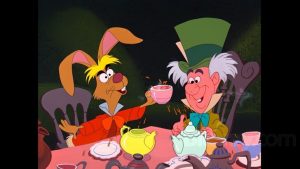
Алиса пыталась рассказать, зачем она пришла, но Заяц и Шляпник всё время меняли темы разговора. Вскоре появился ещё один незваный гость: Белый Кролик, который куда-то опаздывал. Услышав об этом, Шляпник схватил его карманные часы и заявил: «Неудивительно – они же отстают на два дня!» Он попытался починить часы, но в итоге они окончательно спятили, и Мартовскому Зайцу пришлось разбить их молотком.
Безумный Шляпник был одним из свидетелем на суде над Алисой, который устроила Дама Червей. Когда его спросили, где он был, он честно ответил, что сидел дома, пил чай и праздновал не-именины. Тут Король Червей сообразил, что у его жены сегодня тоже не-именины. Шляпник и Заяц попытались устроить безумное чаепитие прямо в суде, однако его случайно сорвало появление Чеширского Кота. Услышав, что рядом кот, Соня перепугался; начался бардак, в котором незаслуженно обвинили Алису. Шляпник и Заяц сбежали из здания суда, а потом появились в мультфильме ещё один раз – когда Алиса удирала от солдат и пробегала мимо их очередного чаепития.
Вот твоя жизнь, Дональд Дак
Шляпник был в толпе диснеевских персонажей, поздравлявших Дональда в конце мультфильма.
Чокнутый
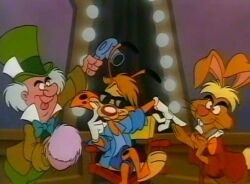
Позже Шляпник появился в сериале ещё несколько раз; самая заметная роль у него в эпизоде «В сумке». В нём он вызвал полицию после того, как у него и Мартовского Зайца украли чайный сервиз. Потом стали пропадать и другие вещи Шляпника, в том числе Мартовский Заяц. Наконец, исчез и сам Шляпник; в конце эпизода выяснилось, что всё это похитил клептоман Гарри Сумка, которому очень не хватало компании. Полицейские хотели арестовать вора, но Шляпник заявил, что теперь эта сумка – его друг.
Всё о Микки Маусе
Шляпник на короткое время появляется в эпизоде «Автомеханики», где говорит, что купил свой цилиндр в магазине шляп в Тунтауне (городе, где живёт Чокнутый).
Король Лев 1.5
В финальной сцене Безумный Шляпник пришёл в кинотеатр, чтобы посмотреть новый мультфильм про Тимона и Пумбу.
Мышиный Дом
Безумный Шляпник – частый гость Мышиного Дома. Обычно он пьёт чай за одним столом с Мартовским Зайцем или Алисой.
В эпизоде «Дональд шутит над Пумбой» Шляпник хохотал над старым мультфильмом про Дональда Дака.
В эпизоде «Отключённый клуб» Микки Маус сообщил, что кто-то в неположенном месте припарковал гигантскую чашку. Шляпник понял, что речь идёт о его транспорте, и пошёл её отогнать, после чего прошёл обратно в клуб между далматинцами и Зевсом. Впрочем, он снова ушёл, когда в клубе вырубился свет.
В эпизоде «Дебют Дейзи» Шляпник хотел получить роль Джинна в «Аладдине», но передумал, когда понял, что волшебная лампа не является чайником.
В эпизоде «Ужин от Гуфи» Безумный Шляпник позвонил по мобильному телефону Дейзи Дак и спросил, можно ли в Мышином Доме отпраздновать не-именины. Когда Гуфи на время заменил Дейзи, Шляпник был посажен за один стол с Клодом Фролло (который был, мягко говоря, не в восторге).
В эпизоде «Смущающее свидание Макса» у Безумного Шляпника было свидание с миссис Поттс.
В эпизоде «Спросите фон Дрейка» Шляпник пытался использовать рукав своей рубашки как фильтр, наливая чай для Алисы.
В эпизоде «Дом Скруджа» Безумному Шляпнику не понравилось, что большой экран заменили маленьким телевизором, но Мартовский Заяц придумал, как исправить положение: выпить уменьшающее зелье, чтобы экран опять казался большим. Когда Скрудж начал экономить на всём подряд и гостям это не понравилось, в клубе остались только Заяц и Шляпник, лишний раз подтвердив, что такой клуб может понравиться только сумасшедшим.
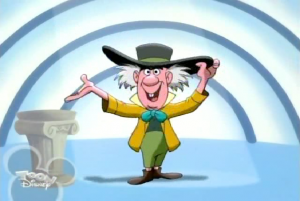
В эпизодах «Микки и волшебное Рождество» и «Микки против Шелби» Шляпник пел песню о том, почему ему нравятся шляпы.
-
Эта статья о персонаж фильма 2010 года. О персонаж из мультфильма 1951 см. Болванщик.
- «Ты сбежал от них, чтобы спасти свою шкуру, ты, мерзкий пильгар-лизоблюд, шукм-жонглирующий слюнявый урпал. Бар лом мук яйцо бримни!»
- ―Таррант Цилиндр говорит Чеширу
Таррант Цилиндр (англ. Tarrant Hightopp), также известный как Безумный Шляпник или просто Шляпник, является главным персонажем из фильма Алиса в Стране чудес и его продолжения Алиса в Зазеркалье. Он мастер шляп, который был отравлен ртутью, поэтому у него оранжевые волосы. Он является частью сопротивления, чтобы свергнуть Красную Королеву командующую Нижнеземьем и таким образом положить конец её кровавому правлению. Его изображает Джонни Депп.
О персонаже
Внешность
Внешне Тарран выглядит как высокий рыжеволосый с зелёными глазами. У него очень бледная кожа, что связано с его ремеслом. Одет он весьма пёстро: из всей одежды можно выделить сюртук, полосатые штаны, коричневые ботинки, пёструю бабочку и цилиндр со швейными принадлежностями. Так же видно, что в молодости у него были более длинные волосы.
Личность
Происхождение Тарранта связано с кланом Цилиндр, семьей Шляпников, которая предположительно была уничтожена Бармаглотом, посланной Красной Королевой во время визита Белой Королевы в их деревню в «день Хоревендуша«. Цилиндры действительно не погибли, хотя, как оказалось, они были фактически захвачены и заключены в тюрьму Красной Королевой из мести. Хотя Белая Королева была благополучно уведена, Вострый Меч (как и её корона) был потерян в суматохе. Таррант считался единственным оставшимся членом своего клана — все остальные были убиты или сожжены дотла. Таррант избежал разрушения только потому, что увел испуганную лошадь Белой Королевы от первоначальной атаки. Он возвращается после того, как находит деревню сожженной дотла, с потрясенным выражением на лице он наклоняется, чтобы поднять свою фирменную шляпу. Когда мы в следующий раз видим его лицо, по полуулыбке становится ясно, что его здравомыслие пошатнулось. Можно увидеть сцену из прошлого Тарранта — Бармаглот, дующий огонь на клан, когда он и Алиса путешествуют, и они проходят через остатки его дома,заставляя его ненадолго вернуться к разрушению.
Разрушение его клана сломало что — то в сознании Тарранта, заставив его оторваться от реальности, а также развить небольшое раздвоение личности. Когда он расстраивается, его глаза из зеленых становятся золотисто-жёлтыми, и он начинает говорить с заметным шотландским акцентом. Таррант может стать жестоким в этом состоянии, если кто-то не вытащит его из него. Мальямкин-Соня в первый раз вырывает его из этого состояния криком: «Шляпник!» – когда он собирается напасть на Чеширского кота, которого винит в нападении на свой клан. Алиса позже выхватывает его из одного из своих эпизодов, когда он заключен в тюрьму в замке Красной Королевы, делая шляпы. Сам Таррант смутно осознает свою личностную проблему, говоря Алисе, что ему нужно выбраться из замка Красной Королевы, говоря, что ему становится все труднее ясно мыслить там.
Появления
Алиса в Стране Чудес
Таррант Цилиндр впервые встретил Алису Кингсли, когда она была маленьким ребенком в возрасте девяти лет. Они быстро подружились, даже вместе пили чай. Алиса забыла эти воспоминания, пока была далеко от Подземелья, но в возрасте девятнадцати лет Алиса снова упала в кроличью нору. Она не помнила Тарранта, когда вновь обнаружила его чайный столик с друзьями и присоединилась к ним в их восстании против Красной Королевы.
Таррант быстро пытается помочь Алисе, особенно когда Красной Королевы приспешники пришли к нему, ища ее. Он дал Алисе зелье, которое уменьшило ее, затем спрятал ее в чайнике и притворился, что никогда не видел ее, даже после того, как был задушен Красной Королевой Валет Червей, Стэйн.
После того, как Стэйн уехал, Таррант взял Алису в путешествие в Мраморный и объяснил царство террора Красной Королевы над Подземье по пути. Вскоре приспешники Красной Королевы учуяли запах Алисы и начали преследовать их. Не имея других вариантов, и враг приближается, Таррант положил Алису поверх своей шляпы и бросил её через реку на противоположную сторону (спасая ее от красных рыцарей), но затем привлекает внимание к себе и попал в плен в процессе. Его уводят, а Алиса продолжает наблюдать.
Стэйн пытался пытать его, чтобы получить информацию о местонахождении Алисы, но его безумие защищало его от методов пыток. Когда Алиса прибыла в Кримс, Тарранта привели в тронный зал, и он решил отвлечь Красную Королеву от казни, надев на нее шляпу. За то время, что он был ее пленником, он сделал много шляп для нее, чтобы примерить. Однако, когда королева примеряла их, она ненавидела их всех.
После того, как Алиса была обнаружена и сбежала, Тарранту было приказано быть казненным. Однако во время казни он и Чеширский Кот работали вместе, чтобы помочь ему бежать. Кот замаскировался под Тарранта, используя свои способности к оборотничеству и свою шляпу, таким образом, оставив Тарранта свободным. После того, как уловка была обнаружена, Таррант разгневал Красную Королеву, обратив ее народ против нее, а затем отступил в Мрамореал. Там Белая Королева решила, что у них должен быть чемпион, чтобы уничтожить Бармаглот. Когда Алиса, предсказанная убийца зверя, не делает шаг вперед, Таррант первым говорит, что он сделает это. Алиса, однако, единственная, кто может победить Бармаглота, и никто другой не может занять эту позицию. Алиса потрясающе прибывает и готова к битве против грязного зверя. Они вместе шли на битву.
Шляпник во время войны Бравного дня против Красной Королевы
Красная королева быстро послала вперед своего защитника, так что Алиса вышла вперед, и битва между ними началась. Однако Таррант быстро вмешался в битву Алисы с Бармаглотом, уколов его хвост мечом, когда тот довольно сильно повалил Алису на землю. В его глазах заметна ярость. Это начинает войну между армиями Красной Королевы и Белой Королевы.
Стэйн обнажил меч, и они с Таррантом быстро вступили в схватку на мечах. Вскоре Таррант обезоружил Стайна и повалил его на землю, подняв меч над головой и готовый пронзить Стэйна. В этот момент становится ясно, что он находится в состоянии безумия, потому что его глаза желтые.
Таррант почти убивает Валета, но останавливается, когда замечает, что Алиса убивает Бармаглота. Затем он с отвращением отбросил меч в сторону. После битвы и победы Таррант отпраздновал ее своим знаменитым танцем «Джига-Дрыга«. Алиса решила покинуть Нижнеземье позже, к печали Тарранта. Он попрощался с ней, и она покинула Нижнеземье.
Алиса в Зазеркалье
Галерея
На Disney Wiki имеется коллекция изображений и медиафайлов, относящихся к статье Таррант Цилиндр.
Прочие
Ссылки
- The Mad Hatters Skin — Alice in Wonderland Wiki
- Mad Hatters’ wardrobe — Alice in Wonderland Wiki
»
| п — р — о
|
||||||||||
|---|---|---|---|---|---|---|---|---|---|---|
|
Сказка «Алиса в стране чудес» — это удивительно доброе и интересное произведение, в котором рассказывается о приключениях маленькой девочки, оказавшейся в вымышленном мире. Сюжетная линия этой сказки замысловата, причём эпизоды быстро сменяют друг друга, что заставляет читателей безотрывно следить за всеми событиями. Характеристики главных героев «Алисы в стране чудес» позволят подготовиться к домашней работе и сделать качественное изложение.
Описание главных героев
Эта сказка повествует о девочке Алисе, которая уснула в парке, увидела белого кролика, погналась за ним и оказалась в небольшой норе, оказавшейся порталом в сказочный мир. Также в этом произведении присутствуют многочисленные второстепенные герои, которые дополняют сюжет, позволяя полностью раскрыть необычный замысел автора.
Список персонажей «Алисы в стране чудес» включает:
- Алису.
- Белого кролика.
- Птицу Додо.
- Чеширского кота.
- Герцогиню.
- Гусеницу.
- Болванчика.
Белый кролик
Белый кролик в этой сказке выступает в качестве проводника для Алисы, именно за ним девочка в начале сказки гонится и попадает через нору в страну чудес. Главной чертой этого персонажа является его трусость. Белый кролик всего боится, он настоящий подхалим, что в особенности проявляется в его разговоре с королевой. Не выполнив важное поручение, он начинает причитать, опасаясь за свою шкурку и голову, а когда королева стала звать зайца, он в страхе убежал.
Заяц известный щёголь, он любит красиво одеваться и красоваться в своём жилете. Его часто можно встретить с веером и в перчатках, с дорогими часами и в элегантном фраке. Кролик живет в собственном доме, у него даже есть прислуга, с которой он общается крайне грубо и пренебрежительно. Но с вышестоящими людьми он всегда заискивает и лебезит перед ними.
Чёрная герцогиня
Герцогиня — это старая, злобная и некрасивая особа. Впервые Алиса встречается с ней в небольшом доме, когда дама на кухне качает младенца, после чего отдаёт его девочке. Вскоре выясняется, что это не маленький ребёнок, а поросёнок, которого Алиса решает отпустить на волю. Несмотря на всю важность, герцогиня позволяет своей поварихе относиться к ней крайне пренебрежительно.
Но при этом со стороны герцогиня не терпит, чтобы ей кто-то перечил, и уж тем более возражал. Она часто посещает балы королевы, принимая участие в многочисленных играх. Герцогиня также заискивает и лебезит перед вышестоящими, но при этом непонятно её реальное отношение к власть держащим. Кролик общается с ней на равных, это позволяет сделать вывод, что, несмотря на высокий титул, всё же этот персонаж не столь значим в иерархии страны чудес.
Чеширский кот
Это один из самых интересных и необычных персонажей этой сказки. Он обладает уникальной способностью возникать из ниоткуда и таким же непостижимым образом бесследно исчезать. Чеширский кот дает Алисе многочисленные советы, знакомит ее со многими персонажами сказочного мира, рассказывая девочке о сложных правилах поведения во время встречи с королевой.
Чеширский кот обладает следующими качествами:
- ум,
- смекалка,
- доброта.
Чеширский кот часто появляется и исчезает по частям, чаще всего можно увидеть его одну лишь голову. Это спасает его от угроз королевы, которая за любое неповиновение грозится отправить смутьяна на эшафот.
Особенностью Чеширского кота является его добродушная улыбка, с которой он всё время встречает Алису. Это, несомненно, добрый и интересный персонаж этой сказки, который во всём стремится помочь своей новой знакомой, не требуя при этом чего-либо взамен.
Червонная королева и король
Королева страшно раздражительна, она всегда недовольна и сердита. Её любимым занятием является приказывать, чтобы провинившимся отрубали голову. Голос у красной королевы противный, пронзительный и резкий. Она часто играет в крикет, но стоит кому-то из подданных зазеваться, как она приказывает отрубить виновнику голову. Впрочем, такие указы не спешат исполнять, а уже через несколько дней несчастных отпускают из темницы.
Червовый король имеет, в отличие от своей супруги, более мягкий характер. Втайне от своей жены он милует всех тех несчастных, кого она приговорила к смерти. Он старается вести себя спокойно, лишний раз не попадаться на глаза своей раздражительной королеве, поэтому даже во время игры держится от неё поодаль.
Шляпник и его друзья
Согласно характеристике Чеширского кота, персонаж Шляпник и его друг Мартовский кот — очень взбалмошные странные товарищи, которые проводят своё время, занимаясь чаепитием за огромным столом. Это веселые и интересные персонажи, которые приглашают Алису присоединиться к ним и провести вечер. По словам Шляпника, он поссорился со стариком, который управляет временем, поэтому оно остановилось для этого героя.
Каждый день на часах постоянно 5 вечера, а это самое время пить чай. Шляпник даже не может вымыть посуду, так как у него совершенно нет на это времени. За столом также сидит маленькая Соня, которая всё время спит. Время от времени она просыпается, вставляет в беспредметный разговор какое-либо замечание и снова засыпает. Двое друзей начинают задумываться о сказанном Соней, после чего их беседа всегда изменяется.
«Алиса в стране чудес» — это интересная, добрая и удивительная книга, в которой автор рассказал он приключениях юной девочки, попавшей в волшебную страну. Уже при жизни автора это произведение стало классическим, а в последующем по нему снимали многочисленные фильмы в различных жанрах. Сегодня эта сказка изучается в школе, поэтому школьникам потребуется составить портрет и биографию Алисы, написав по такой книге сочинения и изложения.
( 5 оценок, среднее 2.4 из 5 )
Жизнь современно человека такова, что он постоянно куда-то бежит, о чем-то тревожится и желает поскорее что-то сделать. А вот про чудеса совсем забывает. Но есть люди, которые замечают их, любят, и они с ними непременно случаются! Девочка Алиса – живой тому пример.
Наверное, нет другой более доброй, увлекательной и поучительной истории, чем «Алиса в Стране чудес». Расскажем же, как любопытная девочка убедилась, что Страна чудес существует, и героически помогла ее добрым жителям победить злую Королеву.
Мы расскажем краткий сюжет сказки «Алиса в Стране чудес». Персонажи также не будут обделены вниманием.
Льюис Кэрролл – тот, который придумал страну чудес
Математик и человек с уникальной фантазией – англичанин Льюис Кэрролл. «Алиса в Стране чудес» не единственное его произведение. Вскоре написал продолжение приключений – «Алису в Зазеркалье».
«Логическая игра» и «Математические курьезы» — это книги Кэрролла, порожденные его вторым призванием – профессией математика.
А была ли Алиса настоящей девочкой?
Известно, что у сказочной Алисы существовал прототип в реальной жизни. Это была вполне себе симпатичная и забавная девочка, да и имя у нее было таким же, как у главной героини.
Именно Алиса Лидделл, дочь одного из друзей Кэрролла, натолкнула писателя на идею для его главного произведения. Девочка была настолько милой и способной, что Кэрролл решил сделать ее героиней сказки.
Алиса Лидделл прожила счастливую и долгую жизнь: она родила троих сыновей и скончалась в возрасте 82 лет.
Вообще, Льюис Кэрролл отличался своим забавным отношением к женщинам: он их называл (считал) девочками вплоть до 30 лет. Впрочем, в его словах есть доля правды… Ученые давно заметили, что есть категория девушек, которая очень медленно взрослеет (в свои 25 такие особы выглядят лет на 16).
Сюжет сказки. Как главная героиня попала в Страну чудес?
Сидела Алиса со своей сестрой на берегу реки. Скучно ей было, откровенно говоря. Но тут рядом пробежал веселый кролик с часами в лапках.
Любопытная девочка побежала за ним… Кролик был совсем не прост – он увлек ее в нору, которая оказалась довольно глубокой – уж больно долго летела Алиса. Приземлилась в зале, имеющем множество запертых дверей.
Перед Алисой встала задача – выбраться наружу из комнаты. Она отваживается съесть предметы, изменяющие рост. Сначала Алиса превращается в гиганта, потом – в малютку.
И наконец, чуть не утонув в своих же слезах (автор очень эпично показывает абсурдность женского плача), выбирается наружу через маленькую дверцу. Перед Алисой расстилается бездонная Страна чудес…
Безумное Чаепитие и финал
Далее девочку встречают интересные персонажи, с которыми ей предстоит выпить чаю. По дороге Алиса видит Гусеницу. Та ей советует покушать грибов, чтобы вновь стать нормального роста. Алиса следует ее совету (во сне и не такое можно сделать): после различных метаморфоз нормальный рост возвращается к девочке.
Во время Безумного Чаепития Алиса узнает о злой Королеве, которую ей предстоит одолеть. Происходит это под аккомпанемент рассуждений Шляпника о природе времени.
Далее следует череда событий, в ходе которых Алиса попадает к злой волшебнице на казнь. В этот момент девочка просыпается. Оказывается, все произошедшее – не более чем плод ее фантазии.
Персонажи книги «Алиса в Стране чудес»
Множество интересных существ населяли Страну чудес, дадим краткую характеристику им:
- Невзрослеющая девочка Алиса – ей посвящена отдельная глава нашей статьи.
- Безумный Шляпник – один из участников Безумного Чаепития, друг Алисы.
- Чеширский Кот – магическое животное с обворожительной улыбкой.
- Королева Червей – явно отрицательный персонаж.
- Белый Кролик – положительный герой, давший весточку Алисе о случившейся беде в Стране чудес.
- Мартовский Заяц – участник Безумного Чаепития. Кэрролл дал ему эпитет сумасшедший: он живет в доме, где все предметы интерьера имеют форму головы зайца.
- Мышь Соня – еще одна участница Безумного Чаепития. Отличается своей способностью внезапно засыпать и просыпаться. Во время своего очередного подъема выдает какую-нибудь интересную фразу. Например: «Я дышу, когда сплю» то же самое, что и «Я сплю, когда дышу!».
- Синяя Гусеница – мудрый персонаж Страны чудес. Задает Алисе сложные вопросы; рассказывает, как можно изменить размер своего тела, откусывая гриб с разных сторон.
- Герцогиня – неоднозначный персонаж сказки. Довольно занудная барышня, участвовала в турнире по Королевскому Крокету.
Первые четыре действующих лица – это основные персонажи сказки «Алиса в Стране чудес». Герои эти будут рассмотрены подробно.
Невзрослеющая девочка Алиса
«Эта странная девочка просто обожала раздваивать себя, становясь двумя девочками одновременно».
Без главной героини немыслима сказка «Алиса в Стране чудес». Персонажи придуманы мастерски, но некоторые все же со временем подзабываются. Алису же забыть невозможно, настолько она необычна и интеллектуально развита для своих лет. Какая же она, эта девочка?
В самой книге про внешность Алисы не сказано ничего. Иллюстратор, рисующий картинки к детской сказке, дал девочке белокурые волосы. Кэрролл же в своих черновиках наделил героиню прекрасной копной каштановых волос, таких же, как у вышеупомянутой Алисы Лидделл. Во всем остальном главная героиня была просто славным ребенком. А вот с личностными чертами все обстоит намного интереснее.
Алиса – вечная мечтательница. Ей никогда не бывает скучно: она всегда выдумает для себя игру или развлечение. При этом главная героиня предельно вежлива со всеми, вне зависимости от происхождения человека и его личностных качеств. Ну и в меру наивна – это в силу ее юного возраста и мечтательности.
Еще одна неотъемлемая черта Алисы – это любопытство. Именно благодаря ему она попадает во всякие переделки и приключения. В коллективе играет роль наблюдателя: ей обязательно нужно досмотреть, чем закончится дело. Но если ей становится интересно, она пойдет до конца, чтобы удовлетворить свое любопытство. И выберется из любой ситуации невредимой, благодаря своей неиссякаемой изобретательности.
Друг Алисы — Безумный Шляпник (Болванщик)
«Нынче все ездят по железной дороге, но шляпные перевозки куда надежней и приятней».
Является одним из ключевых персонажей сказки.
Подружились Шляпник и Алиса. В Стране чудес герои очень разные, но галантный Болванщик один такой. Этот стройный молодой человек отлично разбирается в головных уборах. Мастерски изготавливает парики на любой вкус.
Доставил Алису до дворца Королевы в своей чудесной шляпе (разумеется, проблем с уменьшением роста у главной героини не возникло).
Чеширский Кот
Изобретательным оказался Кэрролл. «Алиса в Стране чудес» полна различными сказочными персонажами, но этот герой обладает особенным шармом.
Сказка не была бы настолько забавной, если бы не Кот. Алиса в Стране чудес общается с этим персонажем и находит его весьма умным животным.
Чеширский Кот примечателен тем, что умеет перемещаться в пространстве — внезапно исчезать и появляться. При этом сам Кот исчезает, но его удивительная улыбка продолжает парить в воздухе. Когда Алиса начинала «глупить», персонаж досаждал ее философскими рассуждениями.
В фильме 2010 года Тима Бертона Кот подтвердил, что является положительным персонажем: он помог избежать казни Шляпника.
Червонная Королева
«Отрубить голову» или «Голову с плеч» — любимые фразы колдуньи.
Явный антигерой или просто ведьма (так ее называли в фильме) – Червонная Королева. Алиса в Стране чудес оказалась не просто так, а с целью победить злую волшебницу и восстановить справедливость.
Королева — очень властная и жестокая женщина: издевается над милыми существами Страны чудес. Считает, что вправе проводить массовые казни. Также командует картами и чудовищным Бармоглотом. Питается положительными эмоциями людей. Но против умной и изобретательной Алисы она бессильна.
Сюжет фильма 2010 года
Мы рассмотрим экранизацию сказки Тима Бертона, состоявшуюся 4 года назад. Фильм получился удачным, поэтому советуем его к просмотру.
Изначально Алиса показана как маленькая девочка, которую мучает один и тот же кошмар. Она приходит к своему папе, он ее очень любит и успокаивает, говоря фразу «Безумцы всех умней».
Далее главная героиня показана взрослой 19-летней девушкой. Ей предстоит выйти замуж за человека, которого она не любит, более того – он до тошноты скучен для нее. Но тут на горизонте появляется забавный Белый Кролик, который машет Алисе часами. Разумеется, девушка бежит за ним, проваливается в нору и оказывается в Стране чудес…
С главной героиней происходят различные события, довольно схожие с сюжетом сказки. Мы не будем их дословно описывать (если что – есть фильм) и сразу перейдем к описанию ролей.
Фильм «Алиса в Стране чудес», персонажи
- Алиса – Миа Васиковска. Актриса стала всемирно знаменита после исполнения роли главной героини. В образ вписалась на все сто процентов.
- Безумный Шляпник – Джонни Депп. Загримированный, галантный и экстравагантный – таким мы знаем Болванщика. В финале фильма актер мастерски танцует Джигу-Дрыгу.
- Красная (Червонная, Злая) Королева – Хелена Картер. Играть отрицательные роли у этой актрисы получается просто отлично.
- Белая Королева – Энн Хэтэуэй. Добрая, задумчивая, ласковая, умеет готовить различные лечебные снадобья.
Намного больше, чем просто детская сказка
«Алиса в Стране чудес», персонажи и автор книги рождают множество интересных мыслей. Дело в том, что данное литературное произведение, с одной стороны — детская сказка, а вот с другой – совсем нет.
Практически каждая строчка книги имеет двойной смысл, связанный с математикой и метафизикой. Философским рассуждениям о природе времени предается Шляпник во время Безумного Чаепития. Есть пример словесной рекурсии, когда Алисе снятся шахматы, а черному королю (из игры) снится главная героиня.
«Алиса в Стране чудес» — это интереснейшая сказка, которая не дает нам забыть про то, что чудеса на этом свете случаются. Ее любят не только дети, но и взрослые, поскольку она наполнена добротой, тонким юмором и оптимизмом. Очаровательны и ее персонажи. «Алиса в Стране чудес» (фото главных героев есть в статье) остается в памяти на многие годы.
«Алиса в стране чудес» главные герои

Странные, но по-своему милые главные герои “Алиса в Стране чудес” — пёстрая галерея персонажей, несущих глубокий смысл и не имеющих внутреннего содержания вовсе. Критика встретила произведение холодно и негативно, никакой художественной ценности и значимости в сказке отмечено не было. Приключения маленькой девочки, запутавшейся в собственных фантазиях, казались необычными и пугающими. Спустя десятилетие книга получила признание, критика разглядела в ней богатый, специфичный художественный язык, внутренний смысл, прелесть абсурда.
Опыт работы учителем русского языка и литературы — 36 лет.
Характеристика героев “Алиса в Стране чудес”
Главные герои
Алиса
Главная героиня, маленькая девочка примерно 7 лет.
Выдумщица и фантазёрка, любознательная, добрая, воспитанная. Её прирождённая черта — любопытство — причина и следствие всего, что происходит с девочкой. Мечтательная и наивная девочка пытается понять иллюзорный мир, в который случайно попадает, но там не действуют известные правила и закономерности. Только ребёнок способен искренне принять правила игры и пуститься навстречу приключениям.
Синяя Гусеница
Жительница Страны чудес, меланхоличная гусеница-философ.
Странное существо, как и все остальные в Зазеркалье. Говорит загадками, её умозаключения нелогичны и бессмысленны. Её речь не преследует никакой цели, только последний совет приносит пользу (как стать больше или меньше, откусывая гриб). Пытается помочь Алисе вспомнить стихотворение, курит кальян. Напоминает старую гувернантку своим ворчанием и постоянными нравоучениями.
Чеширский кот
Житель Страны чудес, ироничный мудрый кот.
Сравнительно безобидный персонаж, улыбается, вальяжничает, играет словами. Его взгляды меняются в зависимости от ситуации, он хитёр и непредсказуем. Умеет исчезать по частям и целиком, поэтому не боится, что ему отрубят голову.
Шляпник
Житель Страны чудес, участник безумного чаепития.
Мастерит шляпы, участвует в чаепитии, на суде. Этого персонажа нельзя назвать галантным или хотя бы вежливым. Делает замечания главной героине, придирается, невоспитан и глуп. Его словарный запас ограничен, а речь неразборчива.
Красная королева
Правительница Страны чудес.
Держит в страхе всех жителей волшебной страны, всем вокруг угрожает казнью, капризничает, как ребёнок. Неумна и непоследовательна в своих действиях. Собирательный образ многих взрослых людей глазами ребёнка. Хитра, любит следить и подслушивать, не терпит отказов и возражений.
Грифон
Существо с чертами льва и орла.
Сопровождает Алису, играет словами, в нём сочетаются мудрость, простота и ребячливость.
Черепаха Квази
Один из подданных Червонной Королевы.
Нечто общее между черепахой и телёнком, персонаж доброжелателен и разговорчив.
Второстепенные персонажи
Мартовский заяц
Житель Страны чудес, участник безумного чаепития.
Достаточно странный персонаж. Предлагает девочке выпить вина, которого нет на столе. Учит Алису всегда говорить то, что на уме. Ему постоянно кажется, что пора пить чай. Все вещи в доме кролика сделаны в форме кроличьей головы.
Соня
Участница безумного чаепития.
Постоянно спит, практически бессловесный персонаж. Если говорит или поёт, то чаще всего — не просыпаясь. Иногда Соня делает замечания Алисе, совершенно абсурдные и глупые.
В книге “Алиса в Стране чудес” герои бесцельно проводят время, блуждают, ведут абсурдные речи, изменяют облик или исчезают. Их имена достаточно трудно перевести на русский язык, этим объясняются многочисленные расхождения между оригиналом и русскоязычными версиями. Описание жизни и приключений сказочных существ, а также их характеристика затруднены сложностью жанра — сказка-сон — своеобразный поток сознания без законов и границ. Несмотря на это, сказка Л. Кэрролла получила признание как самое оригинальное произведение своей непохожестью на другие и отвлечённостью от реальной жизни.
Посмотрите, что еще у нас есть:

